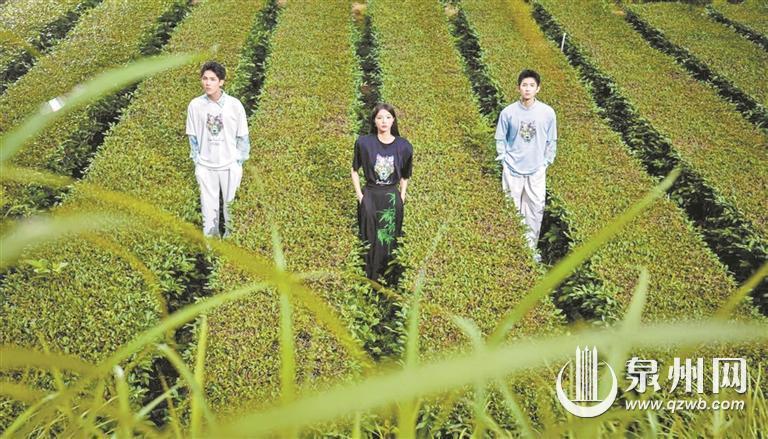- Innovation
- Fusion

Tea Meets Fashion: Models Showcase in a Serene Tea Garden
In May, the hills of Anxi were steeped in the rich aroma of tea. Under the theme "Savour the Flavour of Heritage, Embrace Fashion's Pulse," the "World Heritage Quanzhou: Capital of Fashion" event series launched a striking debut at the Huaxiangyuan Tieguanyin Tea Estate. Marking Fujian's first "tea + fashion" crossover show, Huaxiangyuan Tea joined hands with fashion label Septwolves to spotlight an imaginative dialogue between Chinese tea culture and Guochao Cultural Revival style. Guests from China and abroad, including leaders from government, business, and creative industries, gathered to witness fashion's powerful fusion with heritage in a lush tea garden setting.
A Fashion Feast:
Blending Ancient Tea Culture with Contemporary Trends
Set amid rolling green tea fields, the event was a sensory spectacle that brought together two cultural powerhouses—Chinese tea and modern fashion. As the fragrance of Tieguanyin lingered in the air, the runway came alive with models striding between rows of tea bushes, dressed in fashion-forward designs inspired by both tradition and trend. This striking visual was a celebration of the Minnan spirit—bold, resilient, and rooted in heritage.
The experience went beyond the runway. A ceremonial tea performance titled "What Makes Chinese Tea Distinctive?" offered a poetic interpretation of traditional tea rituals. Another highlight, the "Tea x Wine: East Meets West" showcase, replaced teacups with elegant flutes—fusing the subtle aromas of tea with the boldness of wine. This imaginative blending of "Eastern restraint" and "Western passion" captured the global potential of Chinese tea. The inauguration of the Xiamen Airlines Tieguanyin Tea Base further underscored this ambition, leveraging the airline's logistics network to expand the international reach of Quanzhou's signature brew.
By transforming a tea garden into a live fashion runway, the event reaffirmed that World Heritage is not static—it's living culture that can evolve with the times. In line with Quanzhou's vision to build itself as a "World Heritage City and Fashion Capital," the integration of ancient tea culture and contemporary aesthetics opened new avenues for cultural and economic development. As one organiser put it, the show offered a new "Tea-Inspired Fashion Aesthetic," blending Tieguanyin's dual World Heritage status with cutting-edge textile and fashion design.
A Mission of the Times:
Building a Self-Sustaining Cultural Economy
Beyond its sensory appeal, the event carried strategic significance. In a roundtable discussion themed "How Can Chinese Tea Go Global?" international experts and industry leaders gathered in the tea fields to explore ways forward.
Azat, Managing Director of Bafumen Group's Far East & Pacific division, Russian tea scholar Dr. Ma Haoming, Septwolves Chairman Zhou Shaoxiong, and Huaxiangyuan Chairman Xiao Wenhua all contributed unique insights. "Every Chinese person has their own cup of tea," said Zhou, stressing that tea's lifestyle wisdom should be expressed through modern, tangible design—such as incorporating tea-inspired motifs into fashion, or curating immersive tea-themed environments that echo global sustainability trends.
Dr. Ma highlighted the importance of creating a "Unified Global Knowledge Framework" to bridge cultural differences. By reimagining tea evaluation through the logic of wine tasting, tea can be made more accessible and trustworthy to global audiences. His view aligns with Azat's observation of tea as a rising symbol in global wellness culture—a form of "Eastern herbal philosophy" gaining favour with younger consumers. Xiao Wenhua's idea of "Tea-Wine Synergy" extended this further: wine's global branding strategies could empower tea, while tea's aesthetic subtlety could inspire new perspectives in the wine market.
This convergence paves the way for an "East-Asian Beverage Ecosystem," linking tea and wine through cultural exports such as cross-border e-commerce, cultural tourism, and IP collaborations. Under the dual currents of "Guochao Cultural Revival" and global cultural diversity, such integration could reposition Chinese tea from a local specialty to a symbol of premium global lifestyle.
Rethinking Innovation:
From Product Crossover to Industrial Symbiosis
Innovation, as highlighted by Quanzhou's "Heritage x Fashion Innovation Task Force," is not just about blending elements—it's about transforming entire systems. When the ancient fragrance of Tieguanyin infuses the threads of the fashion industry, or when the artisanal textures of Dehua porcelain complement modern aesthetics, a new dialogue emerges between tradition and trend. This signals a shift from individual innovation to collaborative ecosystems, where industry clusters form resilient "inner loops" to weather external uncertainties.
The event also redefined the consumer experience. In fashion retail spaces, Anxi tea becomes a tactile cultural symbol—visitors sip while exploring fabrics. In tea-tasting rooms, fashion motifs and Dehua ceramics enhance the multisensory experience, transforming shopping into a cultural journey. This synergy creates a holistic ecosystem uniting R&D, production, circulation, and experience. Fashion's market sensitivity injects dynamism into traditional crafts; tea's cultural capital inspires new design languages; and Dehua porcelain's craftsmanship offers quality assurance for crossover products.
This model of "Integrated Models, Shared Resources, and Collaborative Risk" is not just a creative breakthrough—it's a strategic shift. It weaves tradition into the fabric of global industry, showing how World Heritage culture can evolve in modern markets. The Quanzhou experience is a vivid example of turning ancient legacy into modern vitality, allowing heritage to flourish within the global fashion and lifestyle economy.
By Wang Yujing, Liu Longzhen, Ye Guanqing, and Yang Hua | Quanzhou Daily
